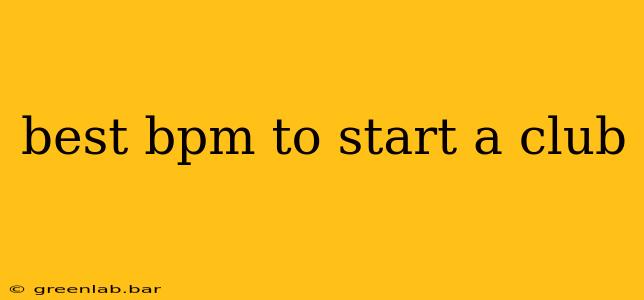So, you're ready to launch your club night, but you're stuck on one crucial element: the tempo. Choosing the right beats per minute (BPM) to start your club is more than just picking a number; it’s about setting the mood, building energy, and ensuring a killer night. This guide dives deep into the science and art of selecting the ideal BPM to get your party started right.
Understanding the Relationship Between BPM and Energy
BPM, simply put, is the speed of the music. It directly impacts the energy level of your club. A slower BPM generally creates a more relaxed, intimate atmosphere, perfect for early-evening sets or certain genres like deep house. Conversely, a faster BPM generates high energy, ideal for peak-time sets and genres like techno or hardstyle.
However, it's not simply a linear relationship. The genre itself significantly influences the perceived energy at a given BPM. A 120 BPM track in tech-house will feel very different from a 120 BPM track in ambient electronica. This is where understanding genre conventions comes into play.
Genre-Specific BPM Ranges: A Quick Guide
This is a general guideline; exceptions always exist, and many tracks will fall outside these ranges.
- Deep House: 118-125 BPM - Often characterized by a soulful, laid-back vibe, perfect for setting a comfortable atmosphere.
- Tech House: 122-130 BPM - A more energetic cousin of deep house, perfect for building the energy gradually.
- Progressive House: 125-135 BPM - A progressive build-up and often incorporates melodic elements.
- Techno: 120-140 BPM (often faster) - Known for its driving, hypnotic rhythms, perfect for intense dance floors.
- Trance: 130-150 BPM - Euphoric and soaring melodies characterize trance, providing energetic highs.
- Hardstyle: 140-155 BPM - Characterized by hard-hitting basslines and aggressive rhythms.
The Art of Sequencing BPMs Throughout Your Night
Think of your club night as a journey. You want to carefully curate the energy levels throughout the night to keep the crowd engaged and entertained.
Starting Slow and Building Momentum
It's generally recommended to start with a slightly slower BPM, around 118-125 BPM, particularly if your night begins early. This allows people to arrive, get comfortable, and gradually acclimatize to the atmosphere. This initial phase is crucial for setting the tone.
Gradually Increasing the Tempo
As the night progresses, gradually increase the BPM. This subtle shift in tempo keeps the crowd engaged and helps build anticipation. Jumping drastically from slow to fast can disrupt the flow and might lose some of your crowd.
Peak Time Power
For peak time (usually the middle of the night), you'll want to hit the higher end of your chosen genre’s BPM range to maximize energy. This is where you'll usually see the most people on the dance floor.
Winding Down Gracefully
As the night nears its end, consider gradually decreasing the BPM again. This allows the crowd to wind down, reducing the jarring effect of an abrupt stop.
Beyond BPM: Other Factors Influencing Your Club's Energy
- Genre: Genre plays a crucial role in determining the energy, regardless of BPM.
- Track Selection: Even within a genre, tracks have varying levels of energy. Carefully select tracks based on their individual characteristics.
- Mixing Skills: A skilled DJ can use mixing techniques to seamlessly transition between tracks and maintain energy.
- Lighting and Atmosphere: The visual aspects of your club also greatly impact the overall energy.
Conclusion: It's About the Whole Experience
Finding the perfect BPM to start your club is a balancing act. It's not just about the numbers; it's about crafting a cohesive musical journey that builds and sustains energy throughout the night. By understanding genre conventions, sequencing BPMs strategically, and paying attention to other factors like lighting and atmosphere, you can create a truly unforgettable club experience. Remember, the best BPM is the one that gets your crowd moving and keeps them dancing all night long.

